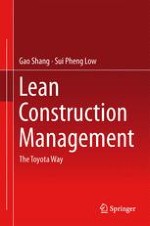2014 | OriginalPaper | Chapter
3. From Lean Production to Lean Construction
Authors : Shang Gao, Sui Pheng Low
Published in: Lean Construction Management
Publisher: Springer Singapore
Activate our intelligent search to find suitable subject content or patents.
Select sections of text to find matching patents with Artificial Intelligence. powered by
Select sections of text to find additional relevant content using AI-assisted search. powered by
